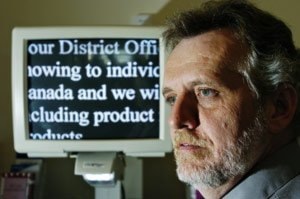Brad Waghorn began losing his sight at age 25 to optic nerve atrophy. It was permanent and degenerative — as the optic nerve deteriorated so did his vision.
Waghorn’s story is a common one and the hardest part was admitting he needed help.
“It took me about five years before I talked to anybody about it,” he said during a visit to Whitehorse Friday.
“When I was travelling alone and I couldn’t see the signs anymore I used to tell people I was illiterate rather than just saying I can’t see the signs. It was that shame-based for me at first.”
Finally, one event motivated Waghorn to come forward and get help.
“Her name was Lynn,” said Waghorn.
He had lost his job and his driver’s licence in a two-week period. He began collecting unemployment, but had trouble filling out the forms because the print was so small.
“I had forgotten to tick a box and she handed me back the sheet and pen, and she got me. I couldn’t see it anymore.
“She hooked me up with a disability counselor and got me funding to go back to school — that was the turning point for me.”
Waghorn finished a degree in social work and took a position as the regional manager for British Columbia and Yukon with the Canadian Institute for the Blind.
Now he helps others cope with vision loss.
Waghorn, who lives in Prince George, BC, was in Whitehorse last week to introduce the CNIB’s new office space in the revamped Captain Martin House on Wood Street.
The Whitehorse chapter of the national organization has a client list of 120, but that doesn’t even scratch the surface of the number of Yukoners with vision problems, said Bernice Montgomery, CNIB rehabilitation services co-ordinator.
She is currently the only Whitehorse-based staffer.
“There are a lot of people who don’t want to come forward — especially older people who don’t want to lose their independence or their (driver’s) licences.”
The new Whitehorse operation, which opened in January, can assess and explain eye-conditions, and refer people to specialists.
Living without sight is challenging, said Waghorn, who has now lost sight completely in one eye and has limited vision in the other. (It’s like looking through a rectangle, he said.)
One of the toughest aspects of vision loss is losing the ability to read people’s expressions through non-verbal cues.
“Generally if people are kidding they’ll follow the statement with a smile, or their eyes will get really big — that part’s getting interesting to figure out.”
He still golfs, curls and plays a little hockey, but driving is impossible.
And things like reading, once a leisure activity, become hard work when you have to move over each word on the page with a heavy magnifier.
Losing vision means thinking about everyday things in a whole different way.
“The fascinating thing about sight is it gives you instantaneous information all the time,” he added.
“You can stand in a room and look around and know who’s all here, and what’s all here — If you’re blind you don’t know anything; you’re world is this far away from you,” Waghorn said and put his hand a half metre away from his body.
“You have to touch things and listen closely for voices. It’s a lot of work.”
And people must re-learn how to do basic daily tasks like turning on an oven or a CD player and paying for a chocolate bar.
Waghorn works to give people simple solutions to cope with everyday situations.
“Money, for example,” he said while fingering a $20 bill. “Paper money feels the same whether it’s a $5, $10, $20, $50.
“And you want to look confident, you want to look smooth when you’re out there.
“Generally I tell people to leave the fives wide open, fold the 10s lengthwise, 20s in half, 50s in half again and then 100s in half again.
“The reason I tell them to put the largest denominations in the smallest folds so that if somebody is dishonest behind them all they’ll see in an open wallet is the fives.”
Sometimes the answers are straightforward, simple solutions.
The CNIB provides low-tech devises like lighted magnifiers and sticky bumps that can be stuck on appliances.
For instance a bump on an oven dial allows the non-sighted to feel where 350 degrees Fahrenheit is.
The institute also provides classes in reading Braille, which takes, on average, two years to learn.
“The hardest part is getting the brain to believe that what you’re feeling instead of what you’re seeing is true,” said Waghorn.
And there are classes on using white canes to navigate city streets.
Sometimes the answers are more high-tech. Two computers boast screen-magnification software, application readers — which read words aloud — and document scanners to scan text into computers.
Right now, the Whitehorse office has two computers for client use and tech-savvy volunteer Bill van Fleet teaches people how to use the adaptive software.
Van Fleet is legally blind. He completed a degree in anthropology at Kwantlen University College in Surrey BC, and did all of his reading and writing with the adaptive technology available through the CNIB.
And clients all over the country can have talking books and descriptive videos — where the action in a movie is described verbally — delivered to their door on loan free of charge, added Montgomery.
“Sometimes I like to throw these on while I do my housework,” she joked.
In May, Waghorn and a quartet of colleagues will come back to Whitehorse to host workshops on everything from business courtesies for those without vision to how to place toothpaste on a toothbrush when you can’t see it anymore.
